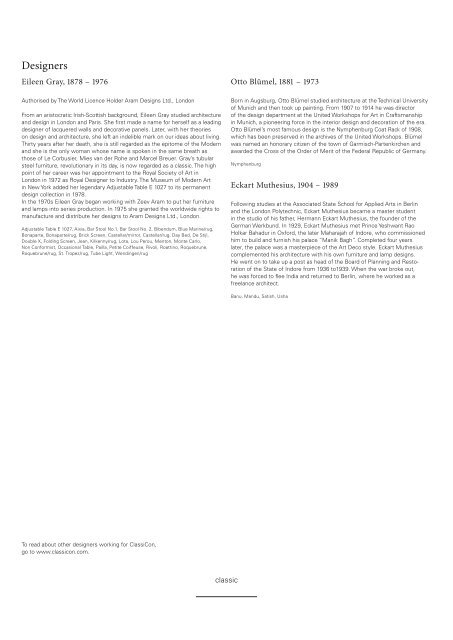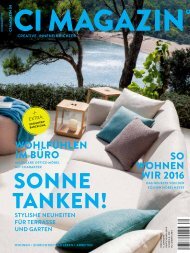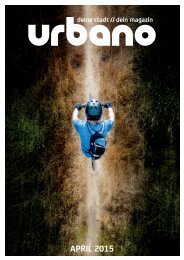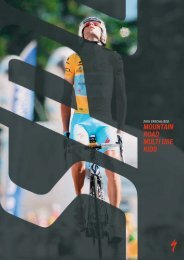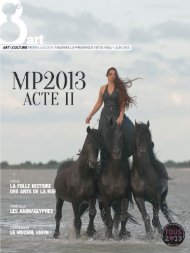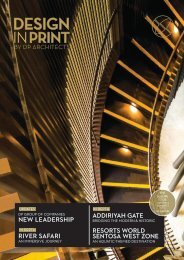Classic Contemporary Design
If we were to go off in search of the ideal place where future and past can meet in order to communicate about the present, the ClassiCon building in Munich would be one of our fi rst choices. Th e modern building, designed by Joachim Jürke, is made of glass, concrete and wood and features a rooft op terrace with a magnifi cent panoramic view of the Alps. Th e company headquarters, including offi ces, warehouse and showrooms, have been located here since 2003 – a place off ering both views and vision.
If we were to go off in search of the ideal place where future and past can meet
in order to communicate about the present, the ClassiCon building in Munich
would be one of our fi rst choices. Th e modern building, designed by Joachim
Jürke, is made of glass, concrete and wood and features a rooft op terrace with a
magnifi cent panoramic view of the Alps. Th e company headquarters, including
offi ces, warehouse and showrooms, have been located here since 2003 – a place
off ering both views and vision.
Create successful ePaper yourself
Turn your PDF publications into a flip-book with our unique Google optimized e-Paper software.
<strong>Design</strong>ers<br />
Eileen Gray, 1878 – 1976<br />
Authorised by The World Licence Holder Aram <strong>Design</strong>s Ltd., London<br />
From an aristocratic Irish-Scottish background, Eileen Gray studied architecture<br />
and design in London and Paris. She fi rst made a name for herself as a leading<br />
designer of lacquered walls and decorative panels. Later, with her theories<br />
on design and architecture, she left an indelible mark on our ideas about living.<br />
Thirty years after her death, she is still regarded as the epitome of the Modern<br />
and she is the only woman whose name is spoken in the same breath as<br />
those of Le Corbusier, Mies van der Rohe and Marcel Breuer. Gray’s tubular<br />
steel furniture, revolutionary in its day, is now regarded as a classic. The high<br />
point of her career was her appointment to the Royal Society of Art in<br />
London in 1972 as Royal <strong>Design</strong>er to Industry. The Museum of Modern Art<br />
in New York added her legendary Adjustable Table E 1027 to its permanent<br />
design collection in 1978.<br />
In the 1970s Eileen Gray began working with Zeev Aram to put her furniture<br />
and lamps into series production. In 1975 she granted the worldwide rights to<br />
manufacture and distribute her designs to Aram <strong>Design</strong>s Ltd., London.<br />
Adjustable Table E 1027, Aixia, Bar Stool No.1, Bar Stool No. 2, Bibendum, Blue Marine/rug,<br />
Bonaparte, Bonaparte/rug, Brick Screen, Castellar/mirror, Castellar/rug, Day Bed, De Stijl,<br />
Double X, Folding Screen, Jean, Kilkenny/rug, Lota, Lou Perou, Menton, Monte Carlo,<br />
Non Conformist, Occasional Table, Pailla, Petite Coiffeuse, Rivoli, Roattino, Roquebrune,<br />
Roquebrune/rug, St. Tropez/rug, Tube Light, Wendingen/rug<br />
To read about other designers working for ClassiCon,<br />
go to www.classicon.com.<br />
classic<br />
Otto Blümel, 1881 – 1973<br />
Born in Augsburg, Otto Blümel studied architecture at the Technical University<br />
of Munich and then took up painting. From 1907 to 1914 he was director<br />
of the design department at the United Workshops for Art in Craftsmanship<br />
in Munich, a pioneering force in the interior design and decoration of the era.<br />
Otto Blümel’s most famous design is the Nymphenburg Coat Rack of 1908,<br />
which has been preserved in the archives of the United Workshops. Blümel<br />
was named an honorary citizen of the town of Garmisch-Partenkirchen and<br />
awarded the Cross of the Order of Merit of the Federal Republic of Germany.<br />
Nymphenburg<br />
Eckart Muthesius, 1904 – 1989<br />
Following studies at the Associated State School for Applied Arts in Berlin<br />
and the London Polytechnic, Eckart Muthesius became a master student<br />
in the studio of his father, Hermann Eckart Muthesius, the founder of the<br />
German Werkbund. In 1929, Eckart Muthesius met Prince Yeshwant Rao<br />
Holkar Bahadur in Oxford, the later Maharajah of Indore, who commissioned<br />
him to build and furnish his palace “Manik Bagh”. Completed four years<br />
later, the palace was a masterpiece of the Art Deco style. Eckart Muthesius<br />
complemented his architecture with his own furniture and lamp designs.<br />
He went on to take up a post as head of the Board of Planning and Restoration<br />
of the State of Indore from 1936 to1939. When the war broke out,<br />
he was forced to fl ee India and returned to Berlin, where he worked as a<br />
freelance architect.<br />
Banu, Mandu, Satish, Usha<br />
Konstantin Grcic, 1965<br />
Konstantin Grcic was born in 1965 in Munich. Following training as cabinetmaker<br />
at Parnham College in England, he studied design at the Royal College<br />
of Art in London from 1988 to 1990. Since setting up his own design studio in<br />
Munich in 1991, he has developed furniture, products and lighting for brands<br />
such as Authentics, Driade, Flos, Iittala, Magis, Moormann, Moroso, Muji,<br />
Plank, Nespresso and Vitra, and indeed many of his products have won<br />
international design awards.<br />
His Mayday lamp, produced by Flos, was added to the permanent collection<br />
of the Museum of Modern Art in New York and won the prestigious Compasso<br />
d’Oro in 2001, as did his design Myto in 2011. Since 2007 Konstantin Grcic<br />
has been named <strong>Design</strong>er of the Year several times by various institutions.<br />
His book “KGID Konstantin Grcic Industrial <strong>Design</strong>” was published by Phaidon<br />
in 2006.<br />
Chaos, Diana, Mars, Odin, Orcus, Pallas, Venus<br />
Edward Barber und Jay Osgerby, 1969<br />
This duo met while studying at the Royal College of Art in London and<br />
started collaborating during their studies. They founded their E. Barber +<br />
J. Osgerby design studio in 1996, and their fi rst piece, “Loop Table”, was<br />
shown in 1998 in Milan by Cappellini. This initial design and the later “Flight<br />
Stool” are today part of the permanent collections of both the Metropolitan<br />
Museum of Art in New York and the Victoria & Albert Museum in London.<br />
E. Barber + J. Osgerby create pieces for the collections of companies<br />
including Magis, Authentics, Cappellini, Venini and Isokon Plus. In addition<br />
to receiving numerable international honours for their work, they were<br />
nominated for the Compasso d’Oro in 2004 and named <strong>Design</strong>ers of the<br />
Year by Blueprint magazine in 2005.<br />
Paris, Saturn<br />
For Use, 1973, 1968, 1971<br />
The three designers making up the For Use trio come from widely divergent<br />
backgrounds: Sven Jonke was born in 1973 in Bremen, Christoph Katzler<br />
in 1968 in Vienna and Nikola Radeljkovic in 1971 in Zagreb. Nikola Radeljkovic<br />
and Sven Jonke studied design at the University of Architecture in Zagreb,<br />
while Christoph Katzler received his degree from the University of Applied<br />
Arts in Vienna. In 1998 the three joined forces under the name “For Use”.<br />
Their interdisciplinary approach encompasses the fi elds of architecture,<br />
industrial design, lighting, furniture and street furniture. Besides ClassiCon,<br />
their clients include Cappellini, Magis and Zanotta.<br />
Satyr, Satyr Armrest, Satyr II, Satyr II Armrest, Satyr Stool<br />
Herbert H. Schultes, 1938<br />
Born in 1938 in Freiburg, Herbert H. Schultes completed engineering and<br />
design studies in Munich. From 1985 to 2000 he was chief designer in<br />
charge of worldwide industrial and corporate design for Siemens AG – fi rst<br />
as managing director of Siemens <strong>Design</strong> und Messe GmbH and then of its<br />
later incarnation, designafairs GmbH. He opened his own design studio in<br />
2000 in Inning am Ammersee. As a leading member of many academies<br />
and institutions, he has made a lasting contribution to promoting German<br />
design. His dedication was recognised in 2001 when he received the<br />
Federal <strong>Design</strong> Promotion Award and also the Cross of the Order of Merit<br />
of the Federal Republic of Germany.<br />
Orbis/table lamp, Orbis/fl oor lamp<br />
Christoph Böninger, 1957<br />
Christoph Böninger studied industrial design in Munich and Los Angeles.<br />
As his dissertation project, he designed the world’s fi rst laptop computer, on<br />
display today at the Pinakothek der Moderne in Munich. Following his studies,<br />
he set up a design department for Siemens in the USA and worked as a<br />
design manager and managing director at Siemens until 2006. In 2010, he<br />
founded Auerberg, an author label for designers and architects. Böninger<br />
has designed numerous pieces of furniture, some of which are today in<br />
the permanent collections of design museums, for example the heightadjustable<br />
“SAX” table for ClassiCon.<br />
Zelos<br />
Clemens Weisshaar, 1977<br />
Clemens Weisshaar was born in 1977 in Munich. Following an apprenticeship<br />
as a metal worker, he studied product design at Central Saint Martins College<br />
of Art and <strong>Design</strong> and the Royal College of Art in London. After two years<br />
as the assistant to Konstantin Grcic, he founded his own studio in 2000. He<br />
advises Rem Koolhaas’ research fi rm AMO in industrial design issues and<br />
works on projects ranging from strategic consulting to exhibition architecture<br />
to product design. Weisshaar lives and works in Munich and Stockholm.<br />
Works by Kram/Weisshaar are part of the permanent collections of the Vitra<br />
<strong>Design</strong> Museum in Weil am Rhein, the Neue Sammlung in Munich, and the<br />
Centre Georges Pompidou in Paris.<br />
Triton<br />
Sauerbruch Hutton, Louisa Hutton 1957, Matthias Sauerbruch 1955<br />
Louisa Hutton and Matthias Sauerbruch studied at the Architectural Association<br />
of London. From 1995 to 2007 Matthias Sauerbruch held professorships at<br />
the Technical University of Berlin and the State Academy of Art and <strong>Design</strong>,<br />
Stuttgart. Both have been teaching at the Harvard Graduate School of <strong>Design</strong><br />
since 2007. Louisa Hutton and Matthias Sauerbruch have developed a<br />
signature architectural language that has brought the Sauerbruch Hutton<br />
studio international recognition since its founding in 1989. A holistic approach<br />
to planning, from urban development all the way down to furniture design,<br />
merges functionality with exacting architectural demands, sensuality with<br />
environmental sustainability. Sauerbruch Hutton’s projects, among them the<br />
Federal Environmental Agency in Dessau (2005) and the Brandhorst Museum<br />
in Munich (2008), have been awarded numerous prizes. Their fi rst highrise,<br />
the GSW Headquarters in Berlin (1999), became part of the architecture<br />
collection of the MoMA in New York in 2009.<br />
Munich Lounge Chair, Munich Sofa, Munich Coffee Table,<br />
Munich Table, Munich Armchair, Munich Chair, Munich Stool<br />
Sebastian Herkner, 1981<br />
Born in 1981 in Bad Mergentheim, Sebastian Herkner studied product design<br />
at the Offenbach University of Art and <strong>Design</strong>, already focusing during his<br />
studies on objects and furniture that conjoin diverse cultural contexts. While<br />
studying, he did an internship with Stella McCartney in London. Herkner<br />
founded his own design studio in Offenbach am Main in 2006 and has done<br />
work for manufacturers including De Vorm, nanoo and Moroso, as well as<br />
undertaking projects in the fi elds of interior design and exhibition and museum<br />
design. Since 2007 he has taught several courses at Offenbach University<br />
of Art and <strong>Design</strong> as visiting lecturer. Herkner’s designs have received multiple<br />
awards, among them the 2011 German <strong>Design</strong> Award in the Newcomer<br />
category.<br />
Bell Table<br />
contemporary<br />
P 79


